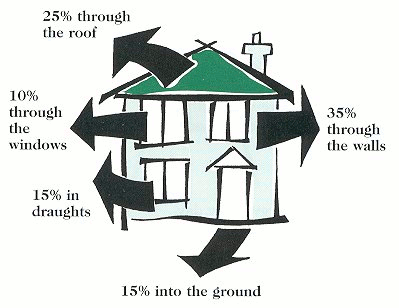Heat Loss Myths
9 01 2009 Heat rises. Such is the oft-quoted bit of wisdom used to justify preoccupation with attic insulation in houses and dismissal of the importance of basement insulation. This basic axiom is not entirely accurate however. Warm fluids (gases or liquids) will rise, this describes how heat moves via convection. Convection heat losses occur from leaks in a non airtight building envelope and in air exchanges through mechanical systems and envelope openings (door and windows). The proper use of air barriers and sealants eliminates or reduces this heat loss. This is not however the only manner of heat loss. Heat also moves via conduction and radiation.Conduction occurs when heat travels through solid matter, from an area of higher temperature to an area of lower temperature until a uniform temperature is achieved. This transfer of heat can happen in any direction, up or down, and always from hot to cold. This is the main source of heat loss in a foundation as the concrete foundation walls are in contact with the warm air inside the house and the cold ground outside the basement walls. The heat inside the house will want to travel tot he cold side of the foundation to achieve equilibrium, however the ground being an almost infinite thermal mass will continue to draw heat from the basement. The use of insulation, which is merely any material with a series of voids which breaks the thermal bridge used in conduction, stops or limits this transfer of heat.
Heat rises. Such is the oft-quoted bit of wisdom used to justify preoccupation with attic insulation in houses and dismissal of the importance of basement insulation. This basic axiom is not entirely accurate however. Warm fluids (gases or liquids) will rise, this describes how heat moves via convection. Convection heat losses occur from leaks in a non airtight building envelope and in air exchanges through mechanical systems and envelope openings (door and windows). The proper use of air barriers and sealants eliminates or reduces this heat loss. This is not however the only manner of heat loss. Heat also moves via conduction and radiation.Conduction occurs when heat travels through solid matter, from an area of higher temperature to an area of lower temperature until a uniform temperature is achieved. This transfer of heat can happen in any direction, up or down, and always from hot to cold. This is the main source of heat loss in a foundation as the concrete foundation walls are in contact with the warm air inside the house and the cold ground outside the basement walls. The heat inside the house will want to travel tot he cold side of the foundation to achieve equilibrium, however the ground being an almost infinite thermal mass will continue to draw heat from the basement. The use of insulation, which is merely any material with a series of voids which breaks the thermal bridge used in conduction, stops or limits this transfer of heat.
 Radiant heat losses occur when electromagnetic radiation is released from hot matter (the filament of light bulbs, element in electric heaters or combustion of fuel). This radiation travels in a straight line from it’s source and radiates out like light (which is a form of radiation as well). This radiation is absorbed at different rates by different forms of matter, it travels through air quite easily losing little of it’s intensity while our bodies would absorb more of it and reflective surfaces like foil or mirrors actually reflect and eliminate it’s loss. Normal insulation, being made up of high amounts of voids or air spaces perform poorly in stopping radiant heat losses while large thermal masses like masonry or solid wood absorb a lot of the radiant heat as it passes through it.
Radiant heat losses occur when electromagnetic radiation is released from hot matter (the filament of light bulbs, element in electric heaters or combustion of fuel). This radiation travels in a straight line from it’s source and radiates out like light (which is a form of radiation as well). This radiation is absorbed at different rates by different forms of matter, it travels through air quite easily losing little of it’s intensity while our bodies would absorb more of it and reflective surfaces like foil or mirrors actually reflect and eliminate it’s loss. Normal insulation, being made up of high amounts of voids or air spaces perform poorly in stopping radiant heat losses while large thermal masses like masonry or solid wood absorb a lot of the radiant heat as it passes through it.
Categories : Energy Tip
 So we have a new little Iz monster roaming around the house so I thought it might be time to post something on how we are trying to make this happy addition a green addition 😉
So we have a new little Iz monster roaming around the house so I thought it might be time to post something on how we are trying to make this happy addition a green addition 😉




